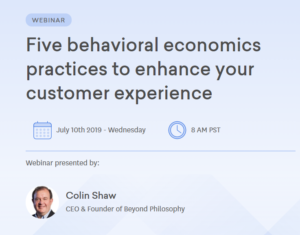Think about the last time you shopped online but decided not to buy. Were you just browsing, or was there something about the user experience that made you hesitate?
For example, you may have felt frustrated by a complicated process for creating an account, or irritated because you couldn’t find basic information such as size charts or a returns policy. Or maybe you got an uneasy feeling when the site wanted to access your Facebook account. Your decision to leave without buying was most likely not about rational issues like price or delivery speed. It was driven by emotional and psychological factors.
This is not unusual—our research shows that more than 50 percent of a customer’s experience is based on emotions. We discussed this in detail when I hosted the first in a series of webinars for Freshworks, How Consumer Emotions Impact Customer Loyalty
To Improve the Digital Experience, You Can’t Ignore Emotions
Most organizations pay little attention to emotions, focusing instead on the rational elements of a customer experience. Less than one percent of data held by organizations relates to the way a customer feels.
Our research shows that there are clusters of emotions that directly impact a company’s Net Promoter Score® and other value metrics. At the low end is the destroying cluster—negative emotions like frustration, anger and feeling neglected. These emotions destroy value, whereas emotions in the recommendation and advocacy cluster – such as feeling happy, pleased and cared for—build long-term value and customer loyalty.
If you only focus on rational factors, you are leaving more than half of the customer experience to chance. You may spend a fortune creating a customer experience that doesn’t make customers feel good at all! For example, we worked with a hospital system that had learned its patients wanted more time with their doctors. The hospital took this at face value and planned to increase the length of each doctor/patient interaction, at a significant cost.
We assessed the patients’ underlying emotions and discovered that they had asked for more time because they felt ignored by doctors who spent much of their patient time entering information into their computers. Giving the patients more time with the doctors would have made the problem worse because patients would have felt ignored for an even longer amount of time. The answer was simply to train the doctors to make eye contact and show that they were listening.
Designing and Evaluating a Digital Experience
The first thing any organization needs to do is to assess what emotions customers are feeling now. Next, an organization must decide which emotions it wants its customers to feel, at each stage in their journey. Then an organization can begin to design a customer experience that leads customers to feel the desired emotions and drives $$$ value .
But how do you assess emotions and design a customer experience in the digital space? You never see your customers face to face, nor do you have a chance to chat with them. Surveys aren’t a reliable source because customers often won’t tell you what they really think.
Facial recognition software is one way to measure that digital experience. Facial recognition is already being used in customer applications. For example, on a recent Delta Airlines flight, I boarded the plane based on facial recognition instead of a boarding pass. KFC in China is getting people to pay with their faces. With that same technology, organizations can use facial expressions to understand how people are feeling at each stage in the digital journey.
Another option is to do facial expression research. By monitoring a group of your customers going through the digital experience and watching for subtle changes in facial expressions, you can see how they are feeling at each stage in the experience. You can assess how your customers are feeling today, and then make changes to the experience and repeat the assessment.
As many of our transactions move online, organizations need to evaluate their digital customers’ emotions and use this as a basis for designing an experience that nurtures the positive feelings that will increase loyalty and long-term value.
Register to find out more about using these strategies to improve your Customer Experience on the next webinar in this Freshworks series on July 10th 2019: Five Behavioral Economics Practices To Enhance Your Customer Experience.
If you enjoyed this blog, you might also like these:
Lose the Fear of Facial Recognition if You Want CX Improvement
Emotions Drive Spending, but Do You Know Which Ones Drive the Most?
Are You Ready for Facial Recognition Technology in Your CX?
Colin Shaw is the founder and CEO of Beyond Philosophy, one of the world’s leading Customer experience consultancy & training organizations. Colin is an international author of six bestselling books and an engaging keynote speaker.
Follow Colin Shaw on Twitter @ColinShaw_CX



